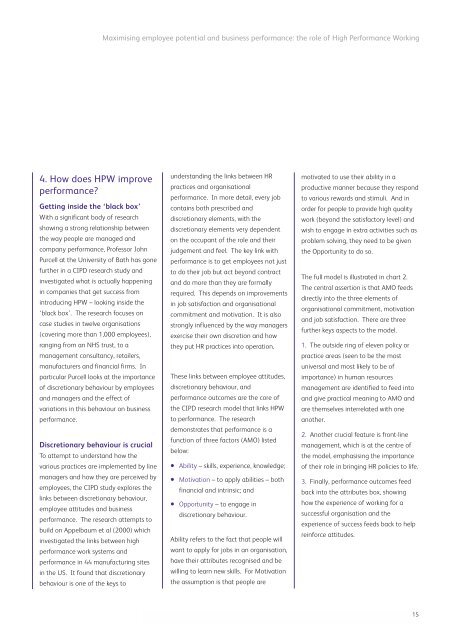About EEF - CIPD
About EEF - CIPD
About EEF - CIPD
Create successful ePaper yourself
Turn your PDF publications into a flip-book with our unique Google optimized e-Paper software.
Maximising employee potential and business performance: the role of High Performance Working4. How does HPW improveperformance?Getting inside the ‘black box’With a significant body of researchshowing a strong relationship betweenthe way people are managed andcompany performance, Professor JohnPurcell at the University of Bath has gonefurther in a <strong>CIPD</strong> research study andinvestigated what is actually happeningin companies that get success fromintroducing HPW – looking inside the‘black box’. The research focuses oncase studies in twelve organisations(covering more than 1,000 employees),ranging from an NHS trust, to amanagement consultancy, retailers,manufacturers and financial firms. Inparticular Purcell looks at the importanceof discretionary behaviour by employeesand managers and the effect ofvariations in this behaviour on businessperformance.Discretionary behaviour is crucialTo attempt to understand how thevarious practices are implemented by linemanagers and how they are perceived byemployees, the <strong>CIPD</strong> study explores thelinks between discretionary behaviour,employee attitudes and businessperformance. The research attempts tobuild on Appelbaum et al (2000) whichinvestigated the links between highperformance work systems andperformance in 44 manufacturing sitesin the US. It found that discretionarybehaviour is one of the keys tounderstanding the links between HRpractices and organisationalperformance. In more detail, every jobcontains both prescribed anddiscretionary elements, with thediscretionary elements very dependenton the occupant of the role and theirjudgement and feel. The key link withperformance is to get employees not justto do their job but act beyond contractand do more than they are formallyrequired. This depends on improvementsin job satisfaction and organisationalcommitment and motivation. It is alsostrongly influenced by the way managersexercise their own discretion and howthey put HR practices into operation.These links between employee attitudes,discretionary behaviour, andperformance outcomes are the core ofthe <strong>CIPD</strong> research model that links HPWto performance. The researchdemonstrates that performance is afunction of three factors (AMO) listedbelow:• Ability – skills, experience, knowledge;• Motivation – to apply abilities – bothfinancial and intrinsic; and• Opportunity – to engage indiscretionary behaviour.Ability refers to the fact that people willwant to apply for jobs in an organisation,have their attributes recognised and bewilling to learn new skills. For Motivationthe assumption is that people aremotivated to use their ability in aproductive manner because they respondto various rewards and stimuli. And inorder for people to provide high qualitywork (beyond the satisfactory level) andwish to engage in extra activities such asproblem solving, they need to be giventhe Opportunity to do so.The full model is illustrated in chart 2.The central assertion is that AMO feedsdirectly into the three elements oforganisational commitment, motivationand job satisfaction. There are threefurther keys aspects to the model.1. The outside ring of eleven policy orpractice areas (seen to be the mostuniversal and most likely to be ofimportance) in human resourcesmanagement are identified to feed intoand give practical meaning to AMO andare themselves interrelated with oneanother.2. Another crucial feature is front-linemanagement, which is at the centre ofthe model, emphasising the importanceof their role in bringing HR policies to life.3. Finally, performance outcomes feedback into the attributes box, showinghow the experience of working for asuccessful organisation and theexperience of success feeds back to helpreinforce attitudes.15
















